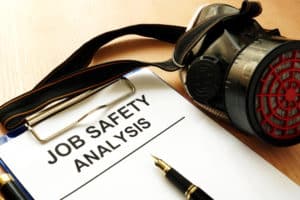
A hazard can be anything that has the potential to cause injury or illness if left uncontrolled. The job hazard analysis is used to identify these hazards before the injury or illness occurs. To do this, the relationship between the employee, the tools or equipment, the work to be accomplished and the work environment is examined. This allows for identification of what the hazards are and then you can decide on the steps to remove the hazards.
Click Link to Access Free PDF Download
“4-Step Sequence For Effective Employee Screening, Hiring, & Placement”
Begin By Reviewing Workplace Records
A job hazard analysis should begin with a review of the workplaces records for accidents and injuries. If you are not already receiving a monthly loss run from your insurance carrier, ask your broker to obtain one for you. This will provide you with information on the nature and type of injuries that have occurred in your workplace. The known hazards can easily be identified in this manner, and this will show you where the existing methods of hazard prevention are not working.
What the loss run does not include is the “near misses” where the employee was lucky enough to escape an incident without injury. This is why the employees in the trenches need to be involved in the identification of hazards. Their knowledge of their job and what can go wrong will assist you in building a completed job hazard analysis. By asking the employees for their input into their safety, the employees will become much more involved in providing valuable insights into the hazards in the workplace.
Obtain Ideas on Eliminating Hazards
Ask the employees what they would do to make their work and their workplace safer. Discuss with the employees their recommendations on how to improve the safety of the work process they follow. Obtain their ideas on eliminating the hazards. Questions you can ask the employees about their work include:
- What has gone wrong before?
- What is likely to go wrong?
- If something goes wrong, what will happen?
- How could the occurrence be prevented?
5. What are other factors that come into play?
- What are the chances that the hazard will occur?
Repeat the list of questions for each hazard each employee identifies. The answers to each question should be written down. The same format should be used with each hazard discussed with any employee. This will assist you in identifying the hazards and provide you with suggestions or recommendations on how to curtail the hazards.
If the employees express their concern about an imminent danger, address the problem immediately. This will show the employees you are serious about protecting them from the hazards of the job. Also, if several employees identify the same hazard, the likelihood of someone getting injured due to the hazard is greater.
After you have been through each of the jobs in the workplace, make a list of the identified hazards. Rearrange the list to rank the hazards that are the highest risk of causing severe injuries. The hazards at the top of your new list should be carefully analyzed to determine how the hazard can be eliminated or at least reduced.
Knowledge of Workplace and Prior Injuries
A job hazard analysis can be conducted on any job in the workplace from clerical to production. Knowledge of the workplace and what injuries have previously occurred is an excellent place to start. Look for:
- jobs that have had the most injuries or illnesses
- jobs with the potential to cause severe injury, even if no prior accidents have occurred
- jobs where a mistake could cause a severe accident
- jobs that have been recently redesigned or changed
- jobs that require written instructions
When you have finished compiling your list of hazards, decide on how the hazards will be reduced or eliminated. The three main ways of dealing with the hazards are engineering controls, administrative controls, and personal protective equipment.
With engineering controls, the facility, equipment or process is redesigned to remove the hazard or to lessen the chance of the hazard occurring. There are many ways this can be accomplished including machine guards, blast shields, lockout systems, hazard enclosure, noise reduction systems, ventilation systems, etc.
Administrative controls would include better employee training, written operating procedures, time limits, changes in workflow, alarms, monitoring and closer supervision.
Many types of personal protective gear can be utilized to reduce or eliminate hazards including safety glasses, hearing protection, hardhat, steel toe shoes, leather gloves, respirators and protective clothing.
Engineering Controls
Normally, the most effective way to control hazards is through engineering controls – for example covering a conveyor belt with a side shield to prevent clothes or jewelry from coming into contact with it. If engineering controls are not feasible or possible, then administrative controls by management changing the work process should be considered. If engineering controls and administrative controls will not prevent the hazard, the introduction of protective gear and equipment should be mandated. A simple thing like steel toe boots and leather work gloves can eliminate some hazards.
With some hazards, a combination of engineering controls, administrative controls, and protective clothing should be used. The job hazard analysis should direct you in determining the hazard control method to be used. By eliminating or reducing the hazards in the workplace, there will be fewer employee injuries and illnesses which will result in lower workers compensation cost and increased employee productivity.















